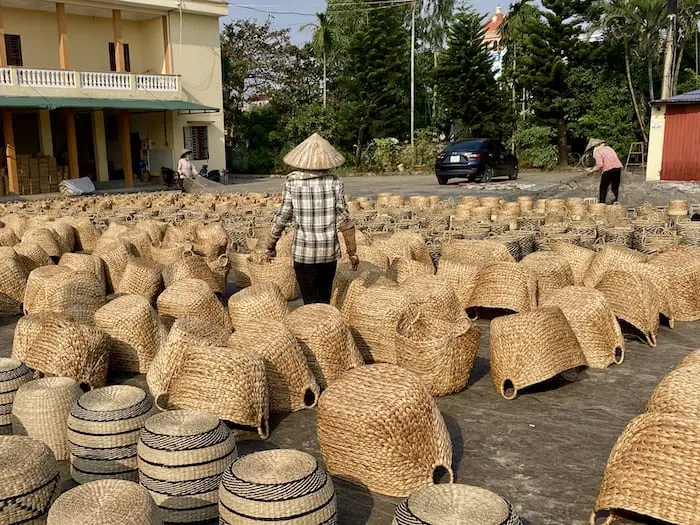Water hyacinth is a weed that once clogged all the waterways around Vietnam. But despite its history, it is now considered an eco-friendly choice for weaving home decor baskets and other home decor products.
Water hyacinths used to be a nuisance on the waterways around Vietnam as the water hyacinth plant grows on the water and is extremely fast-growing. Today the plant is cut and dried and then handwoven into beautiful baskets and other home decor products. The water hyacinth material can be left in its natural color, dyed or painted in various shapes and forms.
Table of Contents
- Video About Water Hyacinth And Other Weaving Production
- What is Water Hyacinth?
- Water Hyacinth Material and Weaving Attributes
- Water Hyacinth Weaving Home Decor Uses
- Frequently Asked Questions
- Related Content
Video About Water Hyacinth And Other Weaving Production
(Click On The Link Below)
What is Water Hyacinth?
Water hyacinth is an aquatic plant that has a slender rootstock kind of stalked leaves. These leaves are then cut and dried to be woven in baskets and other home decor and furniture products. Water hyacinth is widely found in Vietnam, especially in the waterways south of Hanoi.
Water hyacinth grows on the water and floats where the water runs. The plant also has flowers that will grow throughout the northern Vietnamese four seasons. Even in the rainy season, when the water rises in the waterways, the plant will remain green, and small violets can be seen as flowering on the water hyacinth.
Water hyacinth is an extremely fast-growing plant, especially during the springtime. For the plant to grow, it needs to have water. But it is also considered one of the most evasive plants worldwide for the waterways.
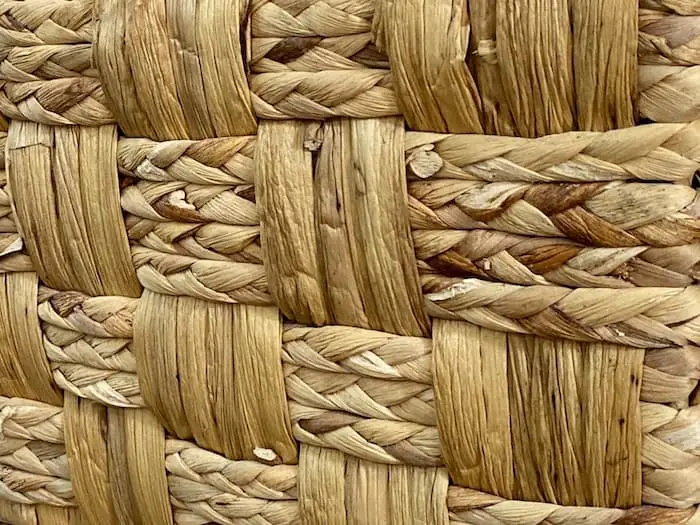
Water Hyacinth – Once A Menace on the Waterways.
For a long time, water hyacinth was considered a useless plant harmful to the waterways and the environment of Vietnam and other parts of the world. The local weavers in the Mekong Delta area of Vietnam, where much of the water hyacinth grows, started to dry and weave the hyacinth plants into home decor and other objects.
In fact, in many parts of Vietnam, these plants on the waterways are considered a nuisance as the growth is so thick that the boats cannot go down the riverways. The water hyacinth will float on the rivers; sometimes, it is so thick that the water beneath it cannot be seen.
This affects the boats’ ability to travel down the waterways and harms the plants and wildlife in the rivers. So, in a way, the cutting of the water hyacinth helps ease an environmental burden on these waterways as the cutting of the water hyacinth plant helps to clear these waterways for the boats and other river life.
Drying Water Hyacinth
Even though water hyacinth is a highly invasive plant that can choke the waterways, it is also quite complicated to dry correctly. The plant must be dried carefully so that the water hyacinth remains pliable when weaving and will not crack when woven. This means it has to be dried in the correct manner and at the correct temperature.
The complications of the drying process are one of the reasons it took a while for this plant to be discovered as a viable source of material for the handwoven production of home decor and home furnishing products.
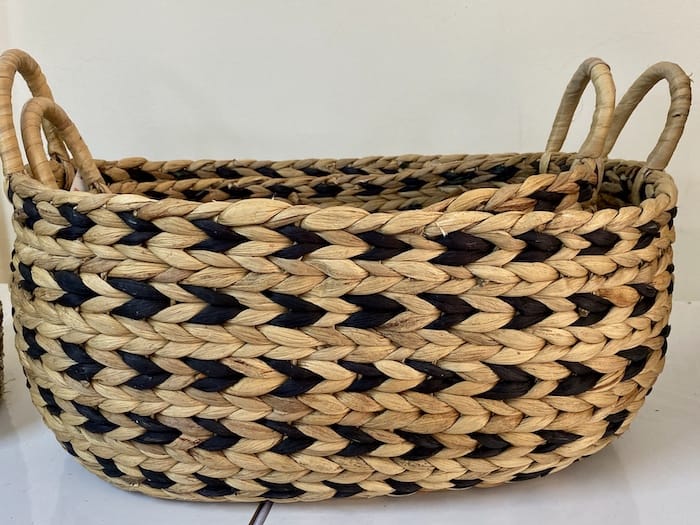
Water Hyacinth Material and Weaving Attributes
There are many ways to use water hyacinths for home decor production. All of the water hyacinth production is 100% handwoven. It cannot be woven by machine.
Here are some water hyacinth material and weaving attributes:
- Handwoven into baskets – Water hyacinth can be woven into a basket without or without a frame. The baskets without the frame can be soft or have a stiffener placed on them so the baskets will keep their shape.
- Variety of weave types – Even though water hyacinth is a very short material, it can be woven in a variety of weaves and a variety of ways. This helps ensure it is a very versatile material.
- Placed on a metal frame – Water hyacinth can also be woven on a metal frame. Woven this way, it usually does not need a stiffener placed on it. Still, all water hyacinth needs to have a chemical treatment after weaving it so that the baskets will stay true to their natural color and not mold or have an insect infestation.
- Dyed in various colorways – One of the great attributes of water hyacinths is that water hyacinths can be dyed in various colors, especially some greens, blacks, and brown colorways.
- Painted colors – Water hyacinth can also be painted.
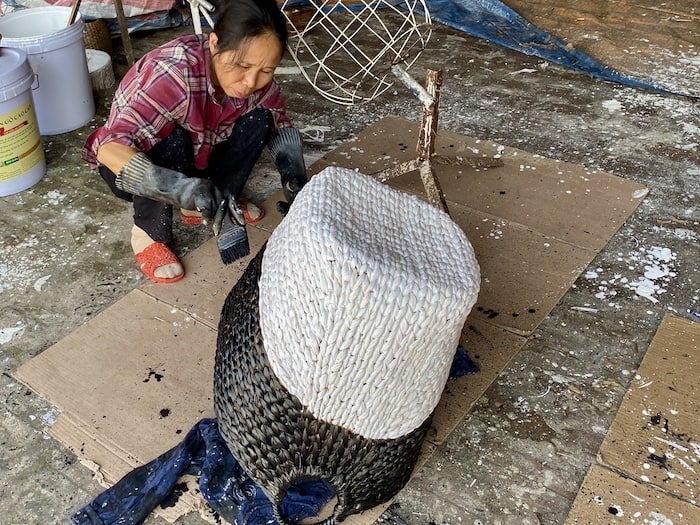
Water Hyacinth Weaving Home Decor Uses
One of the great things about water hyacinth is that it is a very versatile product. When woven, colors can be mixed, and they can also be mixed with other materials like seagrass.
Here are some home decor products that water hyacinth can be used for:
- Baskets – One of the best-known ways to use water hyacinths is baskets. Baskets can be done in various sizes, and as the material is quite thick, it is usually used for some very large baskets. The weave can be with or without a metal frame with the baskets.
- Trays – Like baskets, water hyacinth is also used for trays. Many trays will have a metal frame so that the trays can keep their shape.
- Lamp bases – Water hyacinth can also be used for lamp bases. The lamp bases need also to have a metal frame for the water hyacinth to keep the shape of the lamp base.
- Lampshades and lighting – Water hyacinth is used for many lampshades and lighting products. Like the other products, this must be woven around a metal frame.
- Mirror frames and wall art – A water hyacinth can produce a mirror and wall art with a metal frame.
- Furniture – A water hyacinth is used to weave furniture. Like the other products, it needs to have a metal or some other frame to make furniture pieces out of water hyacinth.
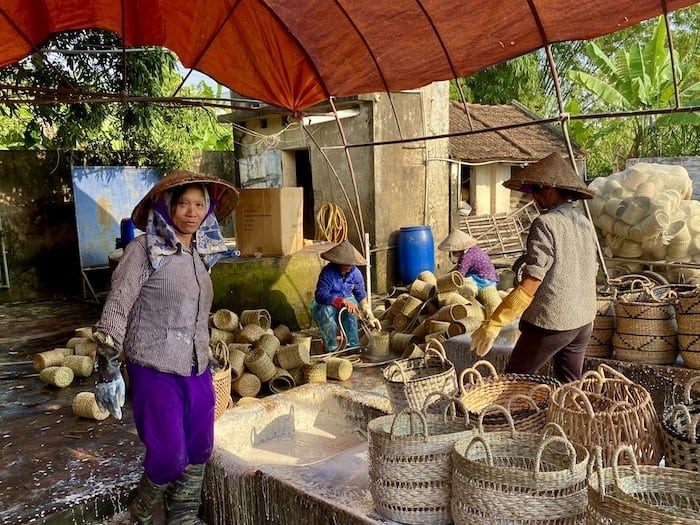
Water hyacinth is a beautiful material that can be used in a variety of ways and in a variety of finishes. When finished, it gives an array of natural looks and has a soft feel for the overall basket.
This is quite a fantastic transformation from a plant once considered a huge nuance to the waterways around Vietnam to now being woven into fantastic home decor and furniture products.
Frequently Asked Questions
Does Water Hyacinth Clean the Waterways?
The roots of the water hyacinth plant can absorb the impurities in the water while also helping to lock up the floating particles in the water. Because of this, it also helps purify the water over time.
Some fish also eat the roots of the water hyacinth plant. But the fast-growing nature of the plant itself is also considered a nuance as it can choke the waterways.
Why is Water Hyacinth Dangerous?
Water hyacinth can be extremely dangerous on the waterways. The reason it is so invasive in that it grows extremely fast, and while it grows, it forms thick layers over the waterways and can shade out other aquatic plants that help some of the river life grow. It can also affect the waterways’ oxygen levels, so many fish species cannot survive.
What is water hyacinth?
Water hyacinth is an aquatic plant native to the Amazon basin. It’s known for its thick, glossy leaves and beautiful violet-to-blue flowers. Despite its attractive appearance, it’s often considered an invasive species due to its rapid growth in waterways.
Why is water hyacinth considered invasive?
Water hyacinth grows very quickly and can form dense mats on the surfaces of water bodies. This growth can block waterways, disrupt aquatic ecosystems, hinder boat navigation, and affect water quality.
Can water hyacinth be used beneficially?
Yes, water hyacinth is used in various ways, including as a material for making furniture, baskets, and other handicrafts. It’s also used in wastewater treatment due to its ability to absorb heavy metals and other pollutants.
How is water hyacinth harvested?
Water hyacinth is usually harvested manually or with machines from the surface of water bodies. The harvested plants are then dried before being used for various applications.
How do you care for water hyacinth products?
Water hyacinth products should be kept dry and cleaned with a damp cloth. It’s important to avoid prolonged exposure to direct sunlight and moisture to prevent damage.
Is it safe to introduce water hyacinth into ponds or water features?
It’s generally not advisable to introduce water hyacinth into ponds or water features, especially in regions where it’s considered invasive. Its rapid growth can lead to ecological imbalances.
Can water hyacinth be composted?
Yes, water hyacinth is compostable. It’s high in nitrogen, making it an excellent addition to compost as a green material.
Mondoro can help you produce water hyacinth products.
Find out more about how Mondoro can help you create, develop, and manufacture excellent home decor and furniture products – don’t hesitate to contact me, Anita. Check out my email by clicking here or become a part of our community and join our newsletter by clicking here.
Mondoro gives out a FREE Lookbook to anyone interested. You can receive a copy of our latest Lookbook by clicking here.
Listen to our Podcast called Global Trade Gal. You can find it on all major podcast platforms. Try out listening to one of our podcasts by clicking here.
Subscribe to our Mondoro Company Limited YouTube Channel filled with great videos and information by clicking here.
Related Content
Eco-Friendly Seagrass Materials Used in Home Decor Products
As the name implies, seagrass is precise grass that grows in the sea or in areas that have saltwater. As Vietnam has access to many tropical oceans, seagrass is abundant in Vietnam. A lot of the seagrass used for manufacturing home decor products is farmed to be cut and processed specifically for seagrass weaving. This seagrass is cut, dried, spun, dyed, and then woven into many items, including baskets, lampshades, furniture, and area rugs. But seagrass also has excellent eco-friendly properties, making it a great alternative to plastic.
You can discover more by reading Eco-Friendly Seagrass Materials Used in Home Decor Products by clicking here.
How to Clean A Seagrass Rug?
A seagrass rug is a great natural addition to your home.
Here are ways you can clean a seagrass rug:
- Vacuum The Rug Regularly – A seagrass rug must be vacuumed regularly with a suction brush. It is good to do this a few times a week.
- Scrap off Spills – If you spill something on the seagrass rug, try to scrap it off it as much as you can. They also try to vacuum clean off the area,
- Clean Up Liquid With A Paper Towel – Clean up any spilled liquid with a paper to wel.
- Wash the Area – You can also wash the area of the spillage. Some soap is a liquid dish soap as Dawn or baby shampoo in some water to clean up with a towel to wash the area mix. Try to get the rug as dry as possible. You can try to dry the air with a blow dryer to get the area completely dry.
To find out more about How to Clean A Seagrass Rug? by clicking this link.

